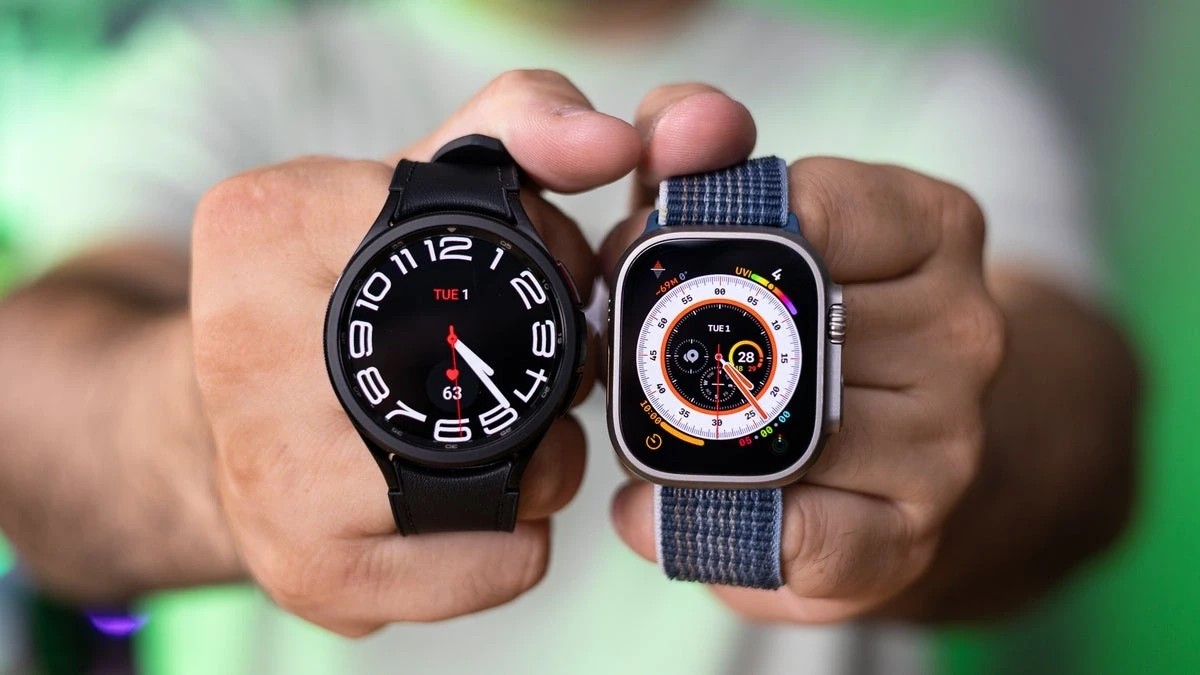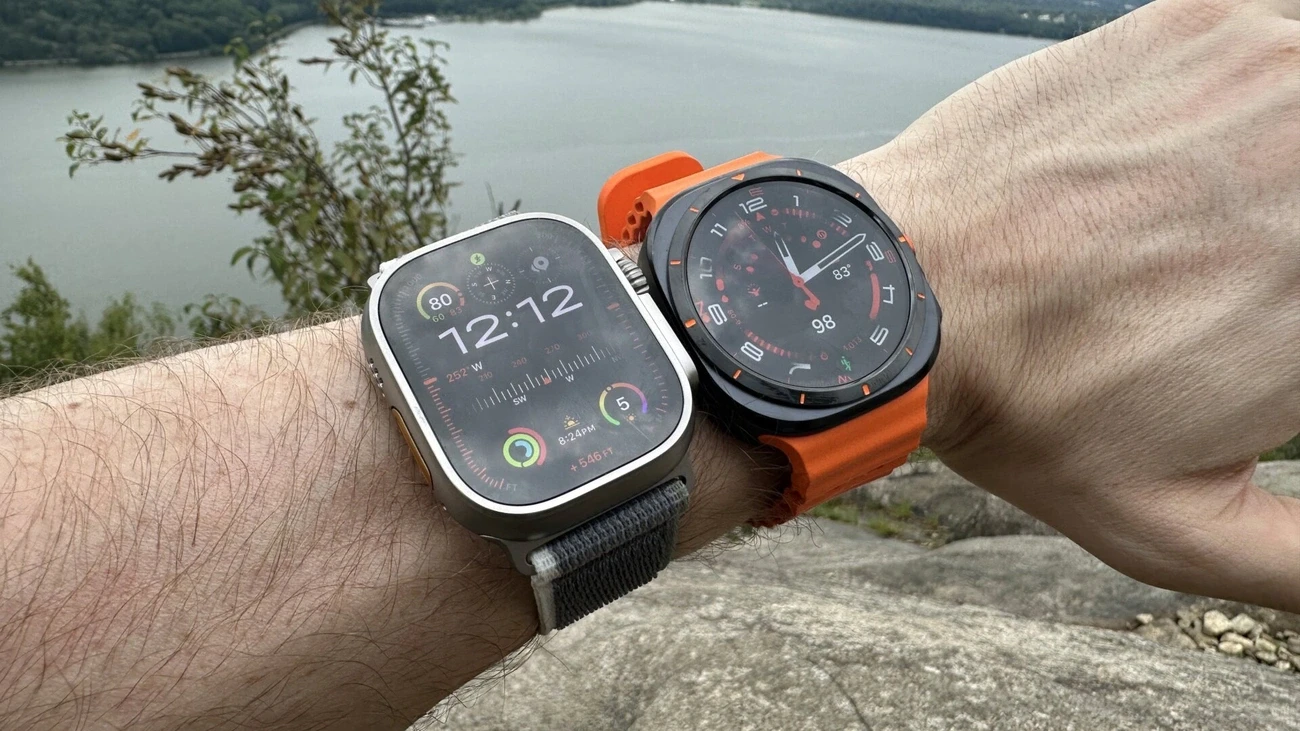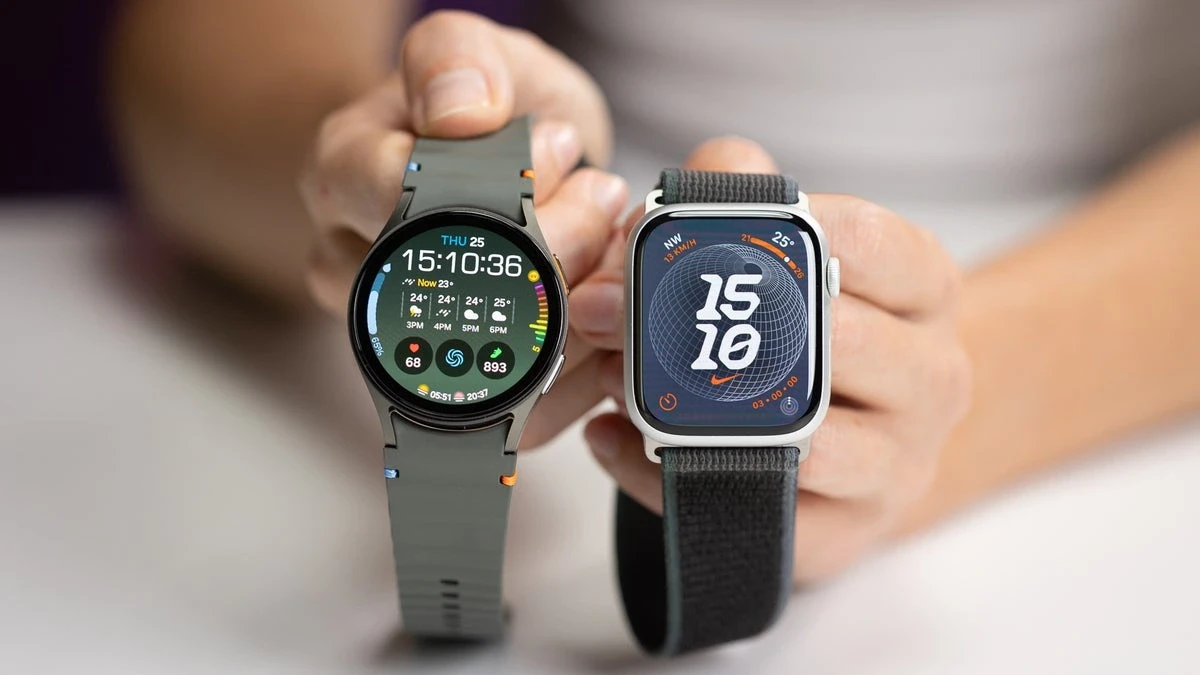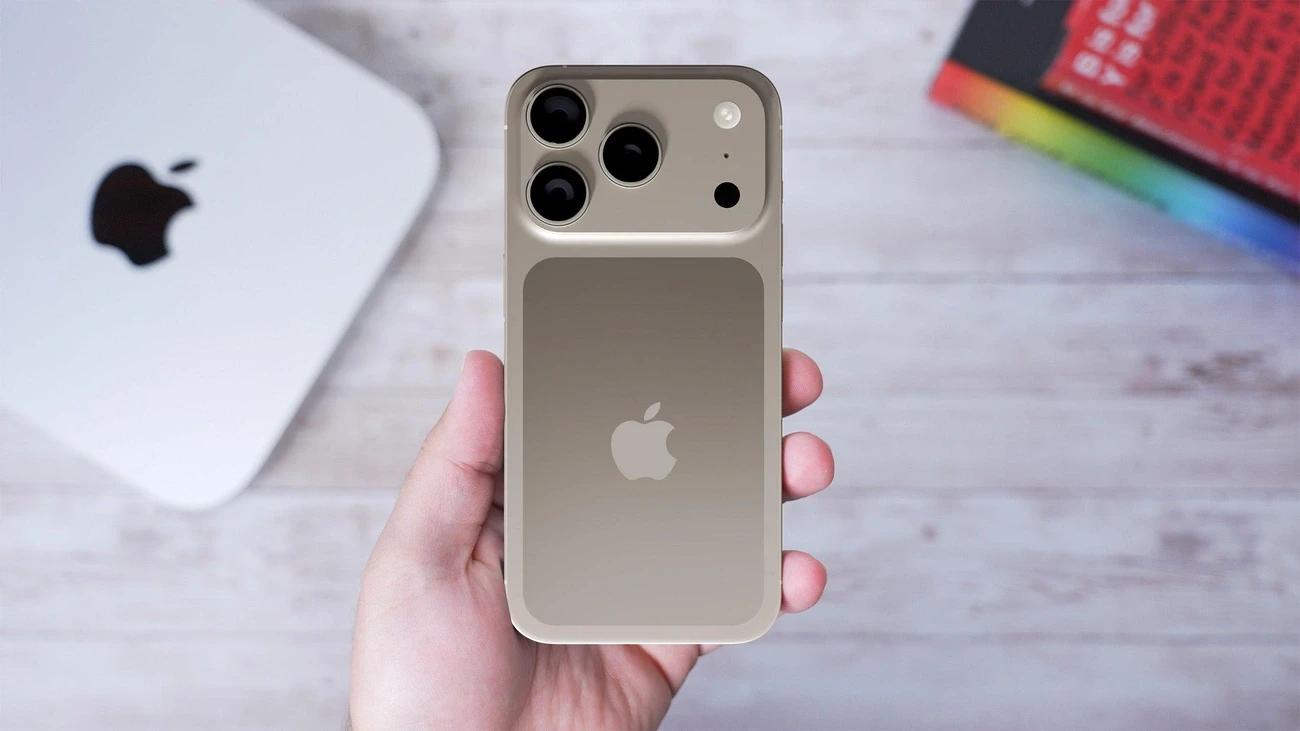Apr 30, 2025
Apple Watch Series 10 or Galaxy Watch 7? An Honest User Experience
The Apple Watch Series 10 (https://amzn.to/436J8gO) and Samsung Galaxy Watch 7 (https://amzn.to/4k5VLQ1) showcase the best in smartwatch technology, but they differ substantially in price and performance. The Apple Watch Series 10 starts at $399 and the Galaxy Watch 7 costs $299, creating a $100 gap between these flagship devices. Both smartwatches showed excellent step count accuracy in tests. The Apple Watch Series 10 missed only 45 steps in a 6,000-step manual count, while the Galaxy Watch 7 had a 57-step difference.
The Apple Watch Series 10's battery performance stands out with 36 hours of use compared to the Galaxy Watch 7's 22 hours under similar test conditions. The Apple Watch Series 10 comes with a larger 1.96-inch display on its 46mm model, while the Galaxy Watch 7's 44mm version has a 1.5-inch screen. These devices share similar peak brightness at 2,000 nits, which makes them easy to read in bright sunlight. The Apple Watch Series 10's design is 10% thinner and lighter than its predecessors, which makes it more comfortable for long-term wear and sleep tracking.
Device Compatibility and Ecosystem Lock-in
"The Apple Watch Series 10 — the best Apple Watch you can buy today — runs watchOS and only works with the iPhone, while the Samsung Galaxy Watch 7 — one of the best smartwatches for Android — runs on Wear OS and works best with one of the best Samsung phones." — Tom's Guide Wearables Expert, Technology publication specializing in consumer electronics reviews
Device compatibility stands as the biggest factor when choosing between the [Apple Watch Series 10](https://amzn.to/436J8gO) and [Samsung Galaxy Watch 7](https://amzn.to/4k5VLQ1). Both are advanced smartwatches that work in different ecosystems. This affects how you can use them and what they can do.
Apple Watch Series 10: iOS-only with iPhone XS or later
The Apple Watch Series 10 sticks to Apple's exclusive approach and works only with iOS devices. Apple's official documentation states that the Series 10 needs an iPhone XS or later running iOS 18 or later. This makes the compatibility range smaller than before. Users with older iPhones like the iPhone X, 8, and earlier models can't use it anymore.
The US Department of Justice points out that Apple's ecosystem creates a "lock-in" effect. Their monopoly case against Apple shows the company sees the Apple Watch Series 10 as a tool that "may help prevent iPhone customers from switching" to other platforms. Users can't take their Apple Watch with them if they switch to Android. The watch keeps them tied to iOS.
Galaxy Watch 7: Android 11+ with best experience on Samsung phones
The Galaxy Watch 7 works with more devices and supports any Android smartphone running Android 11 or later. Samsung has built its own small ecosystem within Android. Users with non-Samsung phones need to download several apps. These include the Samsung Wear app, Samsung Health, and a Samsung Galaxy Watch 7 manager app.
The Galaxy Watch 7 works with many Android devices, but Samsung keeps some key features just for Samsung phone users:
Irregular heart rhythm notifications
ECG and sleep apnea detection
Galaxy AI features and Energy Score
Double pinch gestures
Suggested replies
Reviewers call this Samsung's "walled garden" because it pushes users toward Samsung phones. Older Galaxy Watch models worked with iOS devices, but that changed when Samsung started using Google's Wear OS platform.
Cross-platform limitations and user impact
Smartwatches now help companies keep users in their ecosystems. The Verge says, "Smartwatches have become ways to lock people into ecosystems". This creates real issues for users.
iPhone users looking at a Galaxy Watch 7 face a simple truth—it won't work. Even older Samsung watches that worked with iOS had limited features. Apple's API restrictions blocked functions like quick replies.
Android users face a tougher choice. The Galaxy Watch 7 works with most new Android phones, but non-Samsung phone users miss out on advanced health features. Business Insider explains, "If you don't think you need those features, you'll be fine using the Watch 7 on a non-Samsung Android phone, but Samsung phones will give you a smoother experience".
Things have changed over the last few years. Before 2021, Wear OS watches worked with both iPhone and Android. Google and Samsung's work on Wear OS 3 changed this. The Android ecosystem now copies Apple's exclusive approach.
This goes beyond just watches. Smartwatches now connect with devices like the upcoming Samsung Galaxy Ring, making ecosystem boundaries stronger. Users must think carefully about their smartwatch choice because it affects their phone options. This decision shapes their entire digital experience.
Design and Display Experience

Image Source: PhoneArena
The Apple Watch Series 10 and Samsung Galaxy Watch 7 have physical differences that go beyond looks. These differences show how each company thinks about design and how people use their watches every day.
Shape and Size: Square vs Round Esthetic
These flagship smartwatches look very different from each other. The Apple Watch Series 10 keeps Apple's square design with gentle curved edges. The Galaxy Watch 7 looks more like a traditional round watch. This choice affects more than just looks—it changes how content fits on the screen.
The Apple Watch Series 10's square design gives you about 80mm² more screen space than the Galaxy Watch 7's round display. Square screens show more text and notifications without scrolling. Round screens waste space in the corners.
Both watches have sharp displays. The Apple Watch Series 10 packs 326 pixels per inch. The Galaxy Watch 7's 44mm model comes close with 327ppi.
Display Brightness: 2000 nits on both
Both smartwatches shine bright at 2,000 nits. You can see the screen clearly even in direct sunlight. This is a big step up from older models and matches the brightness of the original Apple Watch Ultra.
The Apple Watch Series 10 uses LTPO3 OLED technology with "wide-angle OLED." The screen looks up to 40% brighter from different angles. The Galaxy Watch 7's AMOLED screen also stays clear from any angle you look at it.
These watches can get very dim too. The Apple Watch Series 10 can go down to just 1 nit. This works great for checking the time at night without waking anyone up.
Material and Durability: Ion-X vs Sapphire Crystal
Materials make a big difference in how tough and clear these watches are. The Apple Watch Series 10 uses Ion-X glass for aluminum models and sapphire crystal for titanium versions. Samsung puts sapphire crystal on all Galaxy Watch 7 models, no matter what the case is made of.
This choice matters in real life. Sapphire crystal can handle a 9-rated pick on the Mohs hardness scale. Ion-X glass scratches at level 8. This means every Galaxy Watch 7 resists scratches better than the basic Apple Watch Series 10.
But there's a trade-off. Sapphire crystal reflects 74% more light than Ion-X glass. In bright outdoor light (2,000 lux), sapphire's contrast ratio drops to 7 while glass stays at 12.
Both watches can handle water up to 50 meters and have IP68 dust protection.
Comfort and Wearability: Weight and Thickness Compared
Both the Apple Watch Series 10 and Galaxy Watch 7 are 9.7mm thick. The Apple Watch Series 10 is thinner than before, dropping a full millimeter from earlier versions.
Weight changes based on size and materials. A 46mm aluminum Apple Watch Series 10 weighs 35.3 grams. The 44mm Galaxy Watch 7 comes in at 34.1 grams. The Apple Watch Series 10 weighs less than the Series 9—which was 51.5 grams for the 45mm model. That's about 10% lighter and thinner.
The Apple Watch Series 10 fits wrists from 130-245mm with its 42mm and 46mm sizes. The Galaxy Watch 7 comes in 40mm and 44mm options. Both fit similar wrist sizes, but Samsung's watch runs slightly smaller overall.
Performance and Software Responsiveness
Processing power defines a smartwatch's responsiveness and capability in daily use. The Apple Watch Series 10 and Samsung Galaxy Watch 7 approach performance differently, each with unique advantages.
Processor Comparison: Apple S10 vs Exynos W1000
The Apple Watch Series 10 comes with Apple's S10 chip, which isn't much different from its predecessor. Apple stayed quiet about this processor since it's just a repackaged version of the S9 chip with the same T8310 architecture. The processor continues Apple's legacy of smooth performance, and users won't notice any slowdowns.
The Galaxy Watch 7 got a major upgrade with Samsung's new five-core Exynos W1000 chip. This processor runs three times faster than the previous Exynos W930. The improvement shows - the Galaxy Watch 7 runs "smooth as glass" with instant app launches and zero lag. Apple's watch might be a bit more responsive, but you'd need both watches side by side to tell the difference.
Storage and RAM: 64GB vs 32GB
The Apple Watch Series 10 leads in storage with 64GB of space. The Galaxy Watch 7 comes with 32GB, which doubles the 16GB from earlier Samsung models.
RAM is vital for smartwatch performance, especially multitasking. Smartwatches use much less RAM than phones - about 512MB on average. More RAM means better handling of simultaneous tasks like step counting and music playback.
App Ecosystem: watchOS 11 vs Wear OS 5
The Apple Watch Series 10 uses watchOS 11, which needs an iPhone running iOS 18 or newer. WatchOS 11's new features are mostly software-based, including the Vitals app, Tides app, and Training Load for workouts. Apple still has more third-party apps to choose from.
The Galaxy Watch 7 runs Wear OS 5 with Samsung's One UI 6 Watch interface. Wear OS 5 optimizes power usage, using 20% less energy during activities like marathon running. A new grid-based app launcher makes app navigation easier. Wear OS now matches watchOS with most major third-party apps available on both systems.
Gesture Controls: Double Tap vs Double Pinch
Both watches let you control them without touching the screen. The Apple Watch Series 10 features Double Tap - users tap their index finger and thumb together twice to perform actions. This works for call answering, Smart Stack scrolling, media control, and navigation.
Samsung created Double Pinch for the Galaxy Watch 7, taking a page from Apple's book. Users can scroll notifications, clear alerts, control media, and take photos with a paired Samsung phone. Double Pinch works great with security camera notifications that don't need replies.
Health and Fitness Tracking Accuracy

Image Source: Gizmodo
"The Apple Watch 10 was off by just 45 steps compared to 57 steps for the Galaxy Watch 7." — Tom's Guide Wearables Expert, Technology publication specializing in consumer electronics reviews
Both flagship smartwatches have better health tracking features, but each one stands out in different ways with accuracy and available features.
Step Count Accuracy: 5,955 vs 5,943 in 6,000-step test
The accuracy test results show impressive precision from both devices. A carefully controlled 6,000-step walk showed the Apple Watch Series 10 counted 5,955 steps (45 steps off) while the Samsung Galaxy Watch 7 logged 5,943 steps (57 steps off). These numbers mean both devices are 99% accurate, making them some of the best step counters you can buy. The tiny difference between them won't matter for your daily step goals.
Heart Rate Monitoring: 118 bpm vs 122 bpm
Heart rate readings show small differences between the watches. Under similar test conditions, the Apple Watch Series 10 showed an average heart rate of 118 bpm while the Samsung Galaxy Watch 7 measured 122 bpm. The Galaxy Watch 7 matches up well with medical devices, showing a 90% match with ECG equipment. The Galaxy Watch picked up heart rate changes faster than Apple's device during hard workouts, especially as people sped up or slowed down.
Sleep Apnea Detection: FDA-cleared vs Apple's 30-day model
Sleep apnea detection works differently on each watch. Samsung got FDA De Novo approval in February 2024. Their feature spots moderate to severe obstructive sleep apnea after two nights of sleep tracking within 10 days. Adults 22 and older can use this feature.
The Apple Watch Series 10 got FDA clearance in September 2024. Their system looks at "breathing disturbances" and uses the accelerometer to spot breathing pattern changes. Users need to wear the watch for 10 nights over 30 days before getting any alerts. This feature works for anyone 18 or older.
Body Composition: BIA on Galaxy Watch 7 only
The Samsung Galaxy Watch 7 has a clear edge with its Bioelectrical Impedance Analysis (BIA) sensor. This smart scale technology sends tiny currents through your body to measure muscle mass, fat percentage, and water content in just 15 seconds. Lab tests show this watch's BIA readings match up perfectly with professional BIA equipment. The feature is 95% as accurate as clinical DEXA scans, bringing professional-grade body measurements to your wrist.
Battery Life and Charging Speed
Battery life is crucial for smartwatch users. Both the Apple Watch Series 10 and Samsung Galaxy Watch 7 make bold claims about their battery performance.
Battery Duration: 18–32 hours vs 22–30 hours
The Apple Watch Series 10 promises 18 hours of "normal use" based on Apple's standards: 300 time checks, 90 notifications, 15 minutes of app usage, and a 60-minute workout with Bluetooth music. Ground testing shows users got 24-30 hours per charge. Some tests even reached 38.5 hours.
The Galaxy Watch 7 promises up to 30 hours with always-on display enabled. This extends to 40 hours when disabled. Battery life was unpredictable at first, but settled around 43 hours in controlled tests.
Charging Time: 0–80% in 30 mins vs 45 mins
The Series 10 brings better charging speeds. The watch hits 80% charge in 30 minutes—this is a big deal as it means faster charging than older models. Tests showed it jumped from 7% to 32% in just 10 minutes.
The Galaxy Watch 7 takes longer to charge, needing about 45 minutes to reach 80%. A 30-minute charge gives you about 36% battery, enough for 23 hours of use.
Always-On Display Impact on Battery
The always-on display feature affects battery life on both watches. This feature uses about four times more battery than when it's turned off. You can get 20% more battery life by turning off the always-on display.
Low Power Modes and Ground Usage
Both watches let you stretch battery life with low-power modes. The Apple Watch Series 10 can run for 36 hours in low-power mode, but you'll need to give up some features:
Always-on display functionality
Double Tap gesture support
Heart rate notifications
Background health measurements
The Galaxy Watch 7 can last about 40 hours with power-saving features turned on. Most active users end up charging both watches daily, especially when using the always-on display.
Pricing, Sizes, and Value for Money

Image Source: PhoneArena
The price differences between the Apple Watch Series 10 and Samsung Galaxy Watch 7 show substantial value variations that buyers should know about.
Apple Watch Series 10 Price Range: $399–$749
The Apple Watch Series 10 keeps the same pricing as earlier models. The 42mm GPS-only aluminum model starts at $399. You'll pay $30 more for the larger 46mm size at $429. Cellular connectivity adds $100 to the price whatever the size - making the 42mm GPS+Cellular $499 and the 46mm GPS+Cellular $529.
Titanium models cost quite a bit more. These start at $699 for the 42mm version with cellular connectivity and go up to $749 for the 46mm option. Aluminum models come in jet black, rose gold, and silver. The titanium versions are available in natural, gold, and slate finishes.
Galaxy Watch 7 Price Range: $299–$379
The Samsung Galaxy Watch 7 costs less upfront. The 40mm model sells for $299 and the 44mm for $329. Many stores now offer big discounts, with the 40mm model selling for $209.99. LTE models cost $50 more, priced at $349 and $379 respectively.
The price gap between similar models runs about $100. Android users can save money by choosing Samsung's option.
Size Options: 42mm/46mm vs 40mm/44mm
The Apple Watch Series 10 comes with new 42mm and 46mm cases. These replace the old 41mm and 45mm sizes. The screens are bigger now - the 46mm model has 1,220 mm² of display area (416 x 496 pixels). The 42mm version shows 989 mm² (374 x 446 pixels).
The Galaxy Watch 7 runs smaller with 40mm and 44mm cases. The 40mm watch has a 1.3-inch display (432 x 432 pixels). The 44mm model sports a 1.5-inch screen (480 x 480 pixels).
Material Choices: Aluminum vs Titanium vs Armor Aluminum
Materials play a big role in durability and quality. The Apple Watch Series 10 comes in aluminum and titanium. Titanium proves more durable and weighs 45% less than stainless steel.
The Galaxy Watch 7 only comes in "Armor Aluminum", Samsung's special aluminum alloy. Samsung puts sapphire crystal displays in all Galaxy Watch 7 models. Apple saves these premium displays for their pricier titanium versions.
Comparison Table
Feature | ||
|---|---|---|
Starting Price | $399 | $299 |
Size Options | 42mm, 46mm | 40mm, 44mm |
Display Size | 1.96-inch (46mm model) | 1.5-inch (44mm model) |
Peak Brightness | 2,000 nits | 2,000 nits |
Battery Life | Up to 36 hours | Up to 22 hours |
Charging Speed | 0-80% in 30 minutes | 0-80% in 45 minutes |
Storage | 64GB | 32GB |
Device Compatibility | iPhone XS or later with iOS 18+ | Android 11+ (best with Samsung phones) |
Step Count Accuracy | 45 steps off in 6,000-step test | 57 steps off in 6,000-step test |
Materials | Aluminum, Titanium | Armor Aluminum |
Display Protection | Ion-X (aluminum), Sapphire (titanium) | Sapphire Crystal (all models) |
Water Resistance | 50 meters | 50 meters |
Thickness | 9.7mm | 9.7mm |
Weight (larger size) | 35.3g (46mm) | 34.1g (44mm) |
Special Features | Double Tap gesture, FDA-cleared sleep apnea detection | BIA body composition, Double Pinch gesture |
Price Range | $399-$749 | $299-$379 |
Conclusion
Conclusion
Your existing ecosystem and specific needs will determine whether the Apple Watch Series 10 or Samsung Galaxy Watch 7 works better for you. These watches have similar thickness and peak brightness, but their core differences affect their overall value.
The Apple Watch Series 10 stands as the only choice for iPhone users because of ecosystem restrictions. Its premium price brings better battery life, more storage space, and slightly more precise health tracking features. The watch's thinner and lighter design makes it much more comfortable to wear all day compared to older models.
Android users will love the Galaxy Watch 7's great value. It costs $100 less to start and comes with exclusive body composition analysis and powerful processing. The watch's sapphire crystal display on every model gives it better durability than base Apple Watches.
Both devices track fitness really well with 99% step count accuracy. They take different approaches to advanced health monitoring like sleep apnea detection. The biggest factor in your choice comes down to ecosystem lock-in - picking a watch ties you more deeply to either iOS or Android.
The Apple Watch Series 10 gives iOS users without doubt the most polished smartwatch experience. The Galaxy Watch 7 matches these capabilities at a lower cost for Android users. Your smartphone choice will point you to which of these excellent watches belongs on your wrist.
FAQs
Q1. How do the Apple Watch Series 10 and Galaxy Watch 7 compare in terms of accuracy? Both watches demonstrate impressive accuracy, with the Apple Watch Series 10 being off by just 45 steps and the Galaxy Watch 7 by 57 steps in a 6,000-step test. Their heart rate monitoring capabilities are also comparable, with only minor variations in readings.
Q2. What are the key differences in compatibility between these smartwatches? The Apple Watch Series 10 works exclusively with iPhones (XS or later with iOS 18+), while the Galaxy Watch 7 is compatible with Android devices running Android 11 or later. However, the Galaxy Watch 7 offers the best experience when paired with Samsung phones.
Q3. How do the battery life and charging speeds compare? The Apple Watch Series 10 typically lasts 24-30 hours and can charge to 80% in 30 minutes. The Galaxy Watch 7 claims up to 30 hours of battery life with always-on display and takes about 45 minutes to reach 80% charge.
Q4. What unique health features does each watch offer? Both watches now offer sleep apnea detection, though with different approaches. The Galaxy Watch 7 exclusively features a Bioelectrical Impedance Analysis (BIA) sensor for body composition measurements, while the Apple Watch Series 10 has received FDA clearance for its breathing disturbances analysis.
Q5. How do the pricing and material options differ between these smartwatches? The Apple Watch Series 10 starts at $399 for aluminum models and goes up to $749 for titanium versions. The Galaxy Watch 7 has a lower starting price of $299 and comes in "Armor Aluminum" with sapphire crystal displays on all models. Apple reserves sapphire crystal for its more expensive titanium models.









